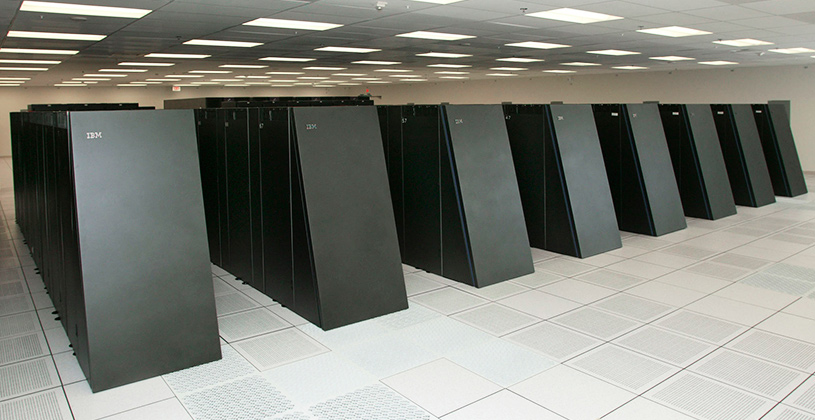 by Chris Banescu –
by Chris Banescu –
As scientific research and advancements, supported by increasingly more powerful computer technologies, delve into the vast complexities of biological organisms, the handiwork and genius of their Creator become more obvious and irrefutable. Recent experiments by researchers using a computer generated “cortical simulator” designed to duplicate a miniscule fraction of the functions of a mouse brain illustrate the immense structural sophistication and the enormous intricacies inherent in all living creatures.
In February 2007 scientists from IBM’s Almaden Research Lab and the University of Nevada used the BlueGene/L supercomputer, equipped with 4,096 processors each using 256MB of memory (for a total of 1 Terabyte (TB) of memory), to run a simulation that attempted to mimic one second’s worth of the processes of half a mouse brain. The “massively parallel cortical simulator” recreated the equivalent of 8,000,000 neurons with 6,300 synapses each, inside the 1 TB main memory of the system. Despite such massive computing power, the vast complexity of the simulation required that the experiment run for a full ten seconds in order to simulate just one second of real time mouse brain activity.
“massively parallel cortical simulator” recreated the equivalent of 8,000,000 neurons with 6,300 synapses each
While the news story assumed that a mouse brain has approximately 16 million neurons, inferring that the cortical simulator (with 8 million neurons) only matched half that number, this author’s own research seems to indicate that mice brains can have anywhere from 30 to 100 million neurons.
Furthermore, scientific studies published in 2000 by the Center for Neuroscience and Department of Anatomy and Neurobiology at the University of Tennessee place the total number of neurons in a mouse brain at approximately 75 million. Given the more accurate neuron numbers, the IBM computer model only simulated one ninth (1/9) to one quarter (1/4) of the neurons in a mouse brain, not one half (1/2) as the story optimistically claimed.
By comparison, a human brain averages a total 95-100 billion neurons. In terms of computing power, the same cortical simulation would theoretically duplicate only 0.008% (that’s 1 divided by 12,500) of the neuron communications a human brain is capable of generating in one second.
What is interesting about this experiment is not its confirmation of the incredible ingenuity and resourcefulness of human intelligence and reasoning, nor its reaffirmance of the astounding capabilities of technology in assisting mankind in the quest for knowledge and understanding, nor the insights gained into the vast complexities and intricacies of biological life.
No, what I find glaringly obvious from the results and methodologies employed in these experiments, is the credibility and powerful support it lends to the truth that life was indeed created by an intelligence and power beyond our understanding and comprehension. Every aspect, methodology, and result of this experiment points us directly back to God, our Creator.
Every aspect, methodology, and result of this experiment points us directly back to God, our Creator.
What is interesting about this story is not how amazingly sophisticated and advanced science and technology have become, but how much weight and credibility it adds to the Judeo-Christian truth that God designed and created all life in all its sophistication and super-complexity.
Notice that it took human reason and logic, resting on and building upon thousands of years of scientific discoveries and innovations, and supported by computer technology also invented and refined by human reason to attempt to duplicate a tiny fraction of the functional capacity of a mere mouse. This entire experiment required structured reasoning, organization, logic, inferences, formulas, calculations, and trial and error methodologies. There was absolutely nothing “random” or chaotic about the processes undertaken by these scientists in working to copy an infinitesimally small slice of a tiny mammal’s cerebral cortex processes. Yet, proponents of the macro-Evolutionary theory claim that purely random events and a mindless Nature are solely responsible for the creation and development of life on our planet over hundreds of millions of years.
 One of mankind’s most powerful supercomputers could only run ten times slower than real life even when attempting to mimic just one second of the brain activity of the lowly mouse. But mindless, chaotic, and random Nature was supposed to have, by chance, invented life and biological systems and organisms trillions of times more complicated and sophisticated. Now that’s indeed a belief system based mostly on blind faith and completely divorced from the reasoned and scientific thinking required to support it.
One of mankind’s most powerful supercomputers could only run ten times slower than real life even when attempting to mimic just one second of the brain activity of the lowly mouse. But mindless, chaotic, and random Nature was supposed to have, by chance, invented life and biological systems and organisms trillions of times more complicated and sophisticated. Now that’s indeed a belief system based mostly on blind faith and completely divorced from the reasoned and scientific thinking required to support it.
In my book review of Uncommon Dissent: Intellectuals Who Find Darwinism Unconvincing I wrote: “Darwinists demand a bigger miracle than any creationist could ever claim, as they assert that “only matter in mindless motion” gave birth to intelligent life and consciousness. Indeed, the faith required to believe that chaos allowed inanimate matter to become alive and to eventually develop into rational beings is far greater than the faith needed to acknowledge that an intelligent Creator designed it all from the beginning.” This latest structured, organized, and reasoned experiment indeed shows that the truth of Creation is no myth.
Related links:
Blue Gene/L – Wikipedia
http://en.wikipedia.org/wiki/Blue_Gene
Blue Gene – from IBM
http://domino.research.ibm.com/comm/research_projects.nsf/pages/bluegene.index.html
Mouse brain simulated on computer
http://news.bbc.co.uk/1/hi/technology/6600965.stm




